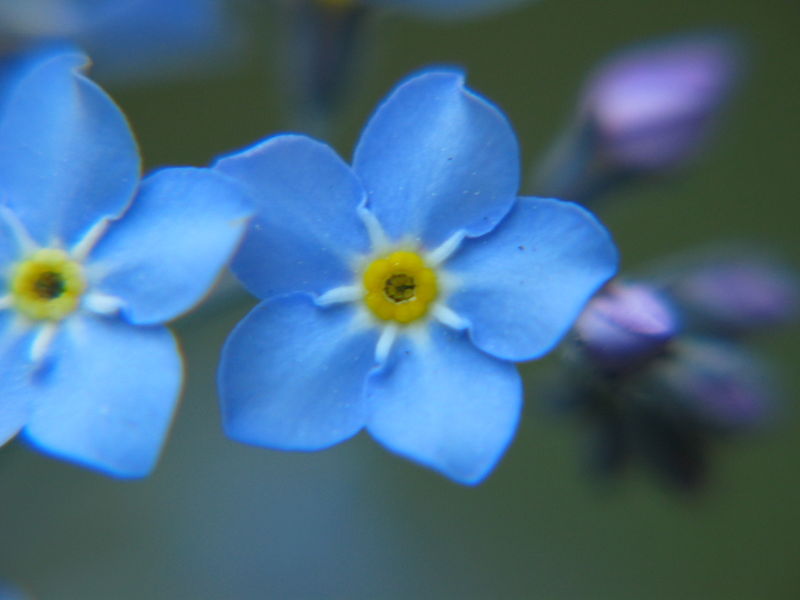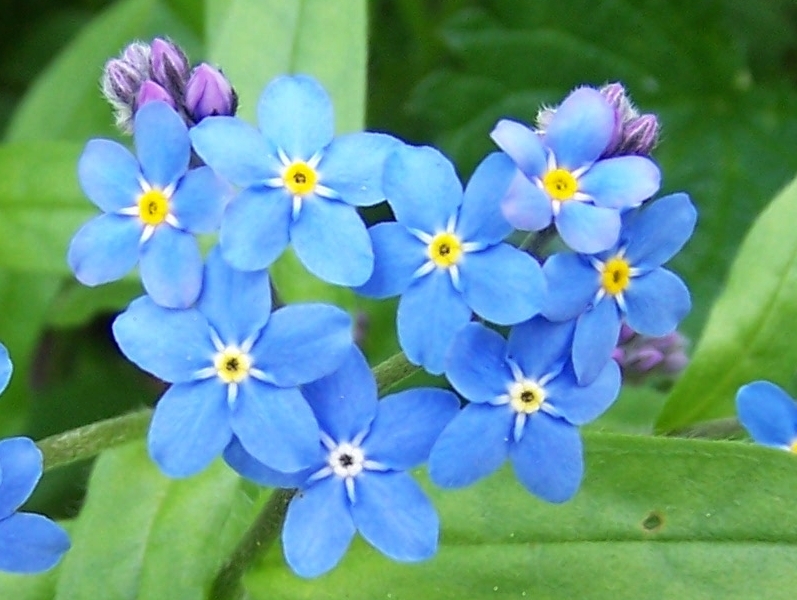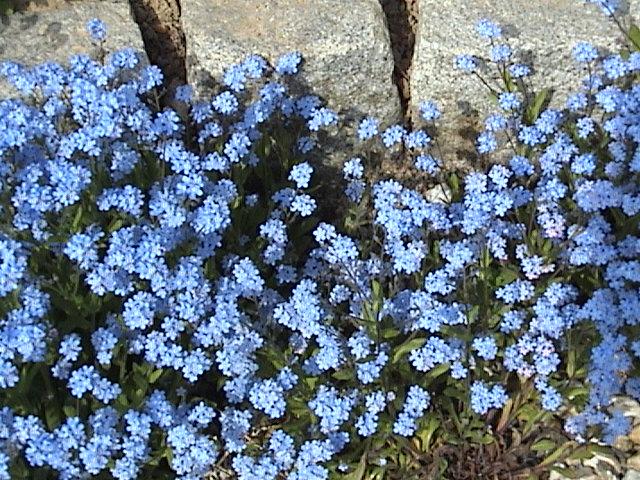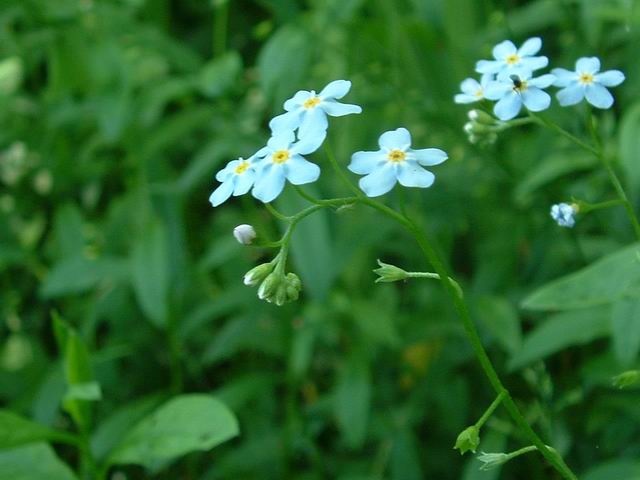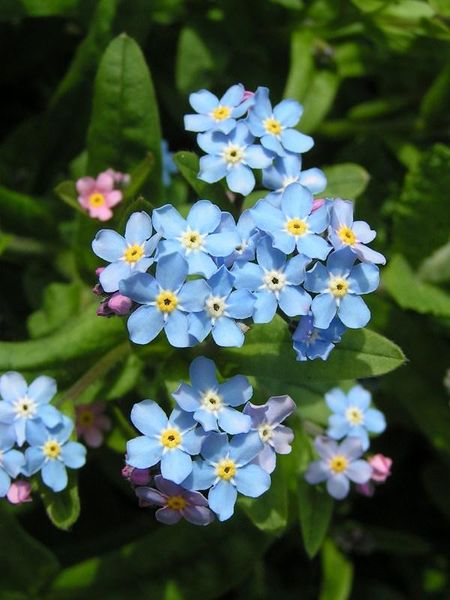Forget-me-notThe Forget-me-nots are the genus Myosotis of flowering plants in the family Boraginaceae. There are about 50 species in the genus, and among them there is considerable variation. Nevertheless a considerable number of the species fit the same description, of a small (1 cm diameter or less) rather flat 5-petalled blue flower growing profusely on straggly stems, flowering in spring. Colour variation is not unusual within species, and white or pink forms are quite likely to be seen. They are popular in gardens, and cultivated forms often show a mixture of colours. The forget-me-nots need shade, not sun. Forget-me-nots can be annual or perennial plants. Their root systems are generally diffuse. Their seeds are found in small, tulip shaped pods along the stem to the flower. The pods attach to clothing when brushed against and eventually fall off, leaving the small seed within to germinate elsewhere. Seeds can be collected by putting a piece of paper under the stems and shaking them. The seed pods and some seeds will fall out. They are widely distributed. Most Myosotis species are endemic to New Zealand, though one or two European species, especially the Wood Forget-me-not, Myosotis sylvatica have been introduced in most of the temperate regions of Europe, Asia and America. Myosotis scorpioides is also known as scorpion grass. In the United States of America, the forget-me-not is the state flower of Alaska, precisely the Myosotis alpestris. Forget-me-nots are used as food plants by the larvae of some Lepidoptera species including Setaceous Hebrew Character. The name was borrowed from Old French "ne m'oubliez pas" and first used in English in c.1532. Loans and translations of it can be found in most European and some non-European languages, like German "Vergissmeinnicht", Italian "Nontiscordardimé", Polish "Niezapominajka", Slovak "Nezábudky", Danish "Forglem-mig-ej", Swedish "Förgätmigej", Dutch "vergeet-mij-nietje", Spanish "no-me-olvides", Russian "Незабудки", Bulgarian “Незабравки”, Lithuanian "Neužmirštuolės", Greek "Μη με λησμονείς" (also connected to the people who died during the 1974 events in Cyprus), Esperanto "neforgesumino", Chinese "勿忘草" (wu wang cao), Korean "물망초" (勿忘草, mul mang cho), Japanese "勿忘草" (Wasurenagusa), Hebrew "זכריני" (Zichrini), Persian "فراموشم مکن" (farâmusham nakon), Hungarian "Nefelejts", Turkish "Unutma Beni" etc. In the 15th century Germany, it was supposed that the wearers of the flower would not be forgotten by their lovers. Legend has it that in medieval times, a knight and his lady were walking along the side of a river. He picked a posy of flowers, but because of the weight of his armour he fell into the river. As he was drowning he threw the posy to his loved one and shouted "Forget-me-not". This is a flower connected with romance and tragic fate. It was often worn by ladies as a sign of faithfulness and enduring love. It is also told in pious legend that the Christ Child was sitting on Mary's lap one day and said that he wished that future generations could see them. He touched her eyes and then waved his hand over the ground and blue forget-me-nots appeared, hence the name forget-me-not. Forget-me-not in popular culture The forget-me-not became the subject of a disco song "Forget Me Nots" by Patrice Rushen in 1982 hitting the Top 10 in many countries. The lyrics include "Sending you forget-me-nots, to help you to remember". This song is notable for the fact its bassline was sampled for George Michael's Fastlove, Will Smith's Men in Black and Pauline Pantsdown's Backdoor Man. Probably also MC Solaar has been inspired by this song (Track: "Les Boys Bandent"). The New Jersey rock band Saves the Day have a song titled "Holly Hox, Forget Me Nots" from the album Through Being Cool. The German band Eisbrecher wrote a song named "Vergissmeinnicht"(Forget-me-not in German). The forget-me-not was also used in the song "Once Upon a Summertime". The lyrics include "A bunch of bright forget-me-nots was all I let you buy me". In 1948 the little blue Forget Me Not[1] flower, or badge, was adopted as a Masonic emblem at the first Annual Convention of the United Grand Lodges of Germany, Ancient Free & Accepted Masons.[2] The flower, or badge, is now universally worn as a Masonic emblem in the coat lapel to remember all those that have suffered in the name of Freemasonry, and specifically those during the Nazi era.[3] [2] In its German version the title of the 2004 Movie Eternal Sunshine of the Spotless Mind has been translated into Vergiss mein nicht!. The forget-me-not is a traditional symbol of Alpha Phi International Fraternity, the fourth Greek-lettered sorority for women, founded at Syracuse University in 1872. The Alzheimer Society of Canada's symbol is the forget-me-not flower. The symbol represents memory loss - one of the symptoms of Alzheimer's disease. [4] In Kingdom Hearts, in Halloween town, Sally gives Sora, Donald, Goofy and Jack a boquet of forget-me-nots as an ingredient for a heart, specifically for memory. In the children's TV programme Fifi & the Flowertots, Fifi herself is an anthropomorphic forget-me-not. Forget-me-not in remembrance The Forget-me-not are traditionally worn by Newfoundlanders on July 1st in remembrance of those Newfoundlanders that died during the First World War. July 1 was chosen because of the high number of casualties suffered by the Royal Newfoundland Regiment on 1 July 1916 during the Battle of the Somme. From Wikipedia, the free encyclopedias |
|
